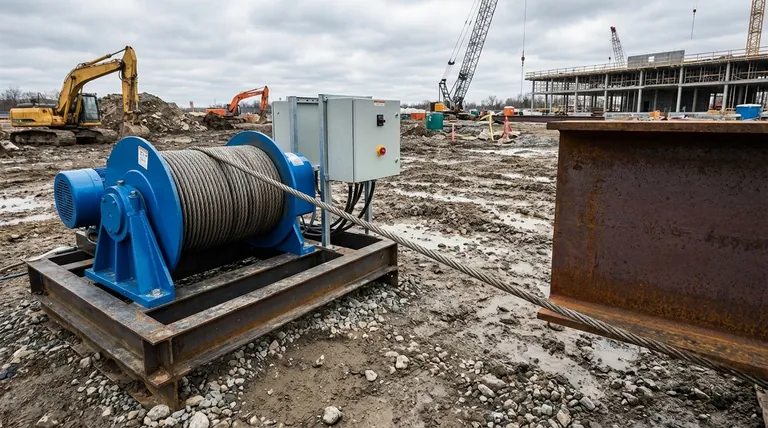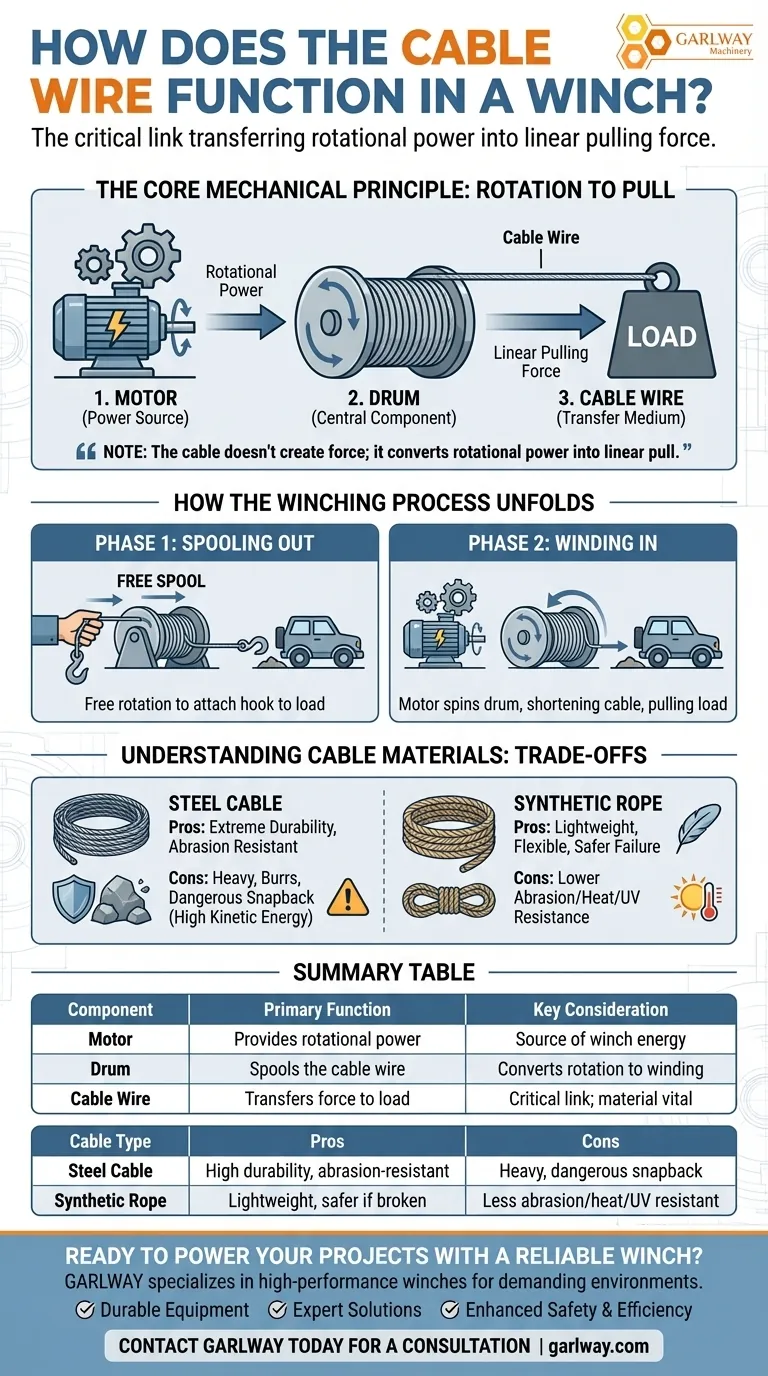In short, the cable wire acts as the critical link that transfers the pulling force generated by the winch's motor and drum to the object you need to move. It is spooled around a central drum; as the motor rotates the drum, the cable winds onto it, creating a powerful and steady linear pull.
The winch cable does not create the force itself. Instead, it functions as the essential medium for converting the winch's rotational power into the linear force required to pull, lift, or tow heavy objects.

The Core Mechanical Principle: From Rotation to Pull
To understand the cable's function, you must first understand the system it operates within. A winch is a simple but powerful machine designed to convert rotational energy into a direct pulling force.
The Power Source: The Motor
The process begins with the winch's motor (in a motorized winch). When activated, the motor provides the rotational power. This is the source of the energy that will ultimately move the heavy object.
The Central Component: The Drum
The motor turns a series of gears that, in turn, rotate a large cylinder called the drum. The drum is the spool that the cable wire is wound around. The rotation of this drum is the central mechanical action of the winch.
The Transfer Medium: The Cable Wire
The cable wire is securely attached to and wrapped around this drum. When the drum rotates, it neatly winds the cable onto itself under tension. This winding action shortens the length of the cable between the winch and the object, pulling the object toward the winch with significant force.
How the Winching Process Unfolds
The function of the cable is best understood by looking at the two phases of a typical winching operation.
Phase 1: Spooling Out
First, the winch drum is allowed to rotate freely in reverse, or "free spool." This lets you pull the cable wire out by hand and attach its hook end to the object you intend to move, such as a stuck vehicle.
Phase 2: Winding In
Once the cable is attached, the winch motor is engaged. The motor spins the drum, which begins wrapping the cable wire around itself. This winding action steadily reduces the distance between the winch and the load, pulling it with controlled and immense force. The entire operation is analogous to a powerful fishing reel reeling in a large catch.
Understanding the Trade-offs: Cable Materials
The material of the cable wire is a critical factor in its performance and safety. The two primary types each come with distinct advantages and disadvantages.
Steel Cable
Steel is the traditional material for winch cables. It is extremely durable and highly resistant to abrasion from being dragged over rocks or rough terrain. However, it is heavy, can develop sharp burrs, and stores a tremendous amount of kinetic energy. If it snaps under load, it can whip back with lethal force.
Synthetic Rope
Modern synthetic winch rope is significantly lighter and more flexible than steel. If it breaks, it has far less mass and is less likely to store and release the same level of dangerous kinetic energy. The primary trade-off is its lower resistance to abrasion and potential damage from heat and UV exposure.
Making the Right Choice for Your Goal
Selecting the right cable is about matching its properties to your specific needs and priorities.
- If your primary focus is maximum durability and abrasion resistance for industrial use: Steel cable remains the most robust choice, provided you follow strict safety protocols.
- If your primary focus is safety, ease of handling, and recreational use: Synthetic rope is the superior option due to its light weight and safer failure characteristics.
Ultimately, the cable wire is the indispensable connection that puts the winch's power to work.
Summary Table:
| Component | Primary Function | Key Consideration |
|---|---|---|
| Motor | Provides rotational power | The source of the winch's energy |
| Drum | Spools the cable wire | Converts rotation into winding action |
| Cable Wire | Transfers force to the load | Critical link; choice of material is vital |
| Cable Type | Pros | Cons |
| Steel Cable | High durability, abrasion-resistant | Heavy, can whip dangerously if broken |
| Synthetic Rope | Lightweight, safer if broken | Less abrasion-resistant, sensitive to heat/UV |
Ready to Power Your Projects with a Reliable Winch?
Choosing the right winch and cable is critical for the safety and efficiency of your operations. GARLWAY specializes in high-performance construction machinery, including robust winches, concrete mixers, and batching plants designed for demanding environments.
We help construction companies and contractors globally by providing:
- Durable Equipment: Built to last and perform under heavy loads.
- Expert Solutions: Tailored to your specific project requirements.
- Enhanced Safety & Efficiency: Reliable machinery that gets the job done right.
Let's discuss how a GARLWAY winch can be the powerhouse for your next project. Contact our experts today for a consultation!
Visual Guide

Related Products
- Best 18000 Pound Drum Anchor Trailer Winch
- Ready Mixer Machine for Construction Ready Mix Machinery
- Electric Hoist Winch Boat Anchor Windlass for Marine Applications
- Heavy Duty Electric Boat Winch Windlass Anchor
- Portable Concrete Mixer Machine Equipment for Mixing Concrete
People Also Ask
- How does using a trailer mounted winch reduce the need for additional equipment? Streamline Your Job Site Logistics
- What factors should be considered when choosing a trailer winch? Ensure Safe & Efficient Load Handling
- How are trailer winches rated? A Guide to Safe & Effective Load Capacity
- What is the primary function of trailer winches? Effortlessly Load Heavy Boats & Equipment
- How does the cable system work in trailer winches? Unlock the Mechanics for Safe & Powerful Pulling








